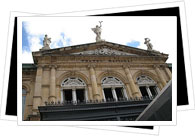
The architecture of Costa Rica is not one of the main pulls to the country given that extreme weather conditions, volcanic activity and frequent earthquakes have destroyed many of the original buildings. This has given rise to a large number of sturdily designed edifices built to stand the test of time rather than to look decorative, for example, the tough and rather solemn looking Basílica de la Inmaculada Concepción in Heredia city.
Costa Rica's towns and cities were once dominated by the typical Spanish colonial architecture of the seventeenth and eighteenth centuries which tended to fuse together solid lines and bold structures with the flamboyant ornamentation of the Churrigueresque. An exuberant Spanish rococo style named after Madrileño architect José Benito Churriguera, whose influence later became commonplace throughout Central America. A wander through the cities of Liberia or Heredia will allow you to see some good examples of Spanish colonial architecture. In particular, Heredia's Casa de Cultura is a well preserved colonial house.
The historic town of Barva (Heredia Province) has been named a national monument and was founded in 1561, making it one of the first towns to be colonised by the Spanish. Barva is brimming with little red tiled houses and offers one of the most intact glimpses of how Costa Rica would have looked in the seventeenth and eighteenth centuries. The town is also home to an impressive nineteenth century white stucco Baroque style church.
The city of San José has lost most of its traditional architecture and now houses many contemporary highrise buildings resemblant of those in any modern day metropolis. The neighbourhood of Amón is the most traditional that you will find with colonial style houses as well as showcasing many of the late nineteenth century mansions which belonged to the wealthy owners of the coffee plantations.
The Teatro Nacional was built in 1897 and has become a recognisable symbol within San José city. The theatre is of neoclassical design and is flanked by elaborate columns, decorative capitals and frescoes. It also displays grand statues of important figures in the history of music and drama, including Calderón de la Barca and Beethoven. The interior is equally as impressive and is adorned by some impressive nineteenth century artwork.